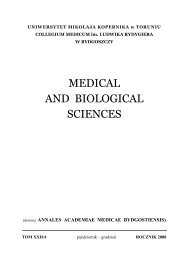medical and biological sciences - Collegium Medicum - Uniwersytet ...
medical and biological sciences - Collegium Medicum - Uniwersytet ...
medical and biological sciences - Collegium Medicum - Uniwersytet ...
Create successful ePaper yourself
Turn your PDF publications into a flip-book with our unique Google optimized e-Paper software.
172<br />
T h e a i m of this study was to determine the relationship<br />
between the prevalence of respective gastrointestinal<br />
symptoms <strong>and</strong> the prevalent clinical manifestation of atherosclerosis<br />
of coronary or peripheral (leg’s) arteries <strong>and</strong> in<br />
some vascular beds (diffuse type).<br />
M e t h o d o l o g y . The investigation was conducted<br />
using an independently prepared diagnostic questionnaire in<br />
97 subjects hospitalised in the Clinic of Gastroenterology,<br />
Vascular Diseases <strong>and</strong> Internal Medicine because of nongastroenterological<br />
reasons. The patients were divided into<br />
four groups regarding the cause of hospitalisation: acute<br />
coronary syndromes, symptomatic peripheral artery disease<br />
(PAD), diffuse atherosclerosis signs, with “non-vascular”<br />
causes of hospitalisation (i.e. pneumonia).<br />
R e s u l t s . Patients with coronary artery disease (CAD)<br />
more frequently than the remaining patients reported heartburn<br />
<strong>and</strong> abdominal pain which usually got better or stopped<br />
after a bowel movement or passing gas. In all patients with<br />
atherosclerosis the percentage of patients with hard lumps<br />
was significantly greater than the percentage of subjects with<br />
soft or watery stools. At the same time in patients hospital-<br />
Julia Kęczkowska i in.<br />
Summary<br />
ised because of “non- vascular” causes such differences were<br />
not found. There were not found significant differences in<br />
prevalence of the remaining symptoms in all four distinguished<br />
subgroups. However, in patients with CAD the<br />
tendency toward more frequent gastrointestinal signs occurred<br />
<strong>and</strong> in individuals with peripheral artery disease the<br />
trend towards less frequent symptoms was observed. The<br />
intensity of respective gastrointestinal symptoms limited or<br />
restricted daily activity of ¼ of the subjects.<br />
C o n c l u s i o n s . 1. Heartburn <strong>and</strong> functional abdominal<br />
pain were more prevalent in patients with CAD, than in<br />
the others. 2. The coexistence of diseases of alimentary tract<br />
should be taken into consideration in every patient hospitalized<br />
due to symptoms of atherosclerosis because of frequent<br />
overlapping <strong>and</strong> mutual masking of the gastrointestinal <strong>and</strong><br />
atherosclerosis-related symptoms, as well as because of their<br />
clinical importance as risk factors for severe gastrointestinal<br />
complications of therapy. 3. The epidemiology, pathomechanism<br />
<strong>and</strong> clinical importance of coexistence of circulatory<br />
<strong>and</strong> alimentary tract diseases need further study.<br />
Słowa kluczowe: objawy gastroenterologiczne, choroby układu sercowo- naczyniowego, epidemiologia, etiologia<br />
Key words: gastroenterological symptoms, cardiovascular diseases, epidemiology, etiology<br />
WPROWADZENIE<br />
Patologie przewodu pokarmowego, rozwijające się<br />
na podłożu przewlekłego niedokrwienia jelit, wtórne<br />
do zwężenia naczyń trzewnych, są stosunkowo rzadkie.<br />
Ze względu na sieć anastomoz między gałęziami<br />
pnia trzewnego, tętnicy krezkowej górnej i dolnej ich<br />
objawy pojawiają się najczęściej dopiero w przypadku<br />
współistnienia istotnych zwężeń co najmniej dwóch<br />
z trzech wymienionych naczyń. Należy pamiętać, iż do<br />
niedokrwienia jelit mogą prowadzić także stany przebiegające<br />
z małym rzutem minutowym serca i/lub<br />
zaburzoną autoregulacją przepływu trzewnego (tzw.<br />
„nieokluzyjne”, czynnościowe niedokrwienie jelit) [1-<br />
3]. Obserwuje się je m.in. u pacjentów z chorobą<br />
wieńcową (ang. coronary artery disease, CAD), niewydolnością<br />
serca, po zabiegach kardiochirurgicznych,<br />
u osób leczonych preparatami naparstnicy lub lekami<br />
moczopędnymi oraz u chorych z miażdżycą rozwidlenia<br />
aorty i tętnic biodrowych w mechanizmie podkradania<br />
drogą tętnic nadbrzusznych. Także miażdżycowe<br />
uszkodzenie ośrodkowego układu nerwowego, na<br />
drodze zmian funkcji neurogennej osi „mózg-jelito”<br />
(ang. brain-gut axis), może zmieniać czynność przewodu<br />
pokarmowego, a tym samym wpływać na symptomatologię<br />
ze strony budujących go narządów. Przykładami<br />
takich stanów klinicznych mogą być zaburze-<br />
nia połykania lub zaparcia w przebiegu zespołów pozapiramidowych,<br />
zespołu opuszkowego, rzekomoopuszkowego<br />
oraz neurogenne zaburzenia funkcji<br />
zwieraczy [4]. Schorzenia te, wskutek zmian równowagi<br />
poziomu neuromediatorów (np. tlenku azotu,<br />
serotoniny), mogą wpływać na tonus naczyniowy oraz<br />
czynność motoryczną i wydzielniczą przełyku, żołądka,<br />
jelit, trzustki i wątroby [5, 6]. Dlatego przeprowadzono<br />
badanie ankietowe, którego celem była ocena<br />
związku między występowaniem objawów gastroenterologicznych<br />
oraz objawami miażdżycy poszczególnych<br />
łożysk naczyniowych, tzn. krążenia wieńcowego,<br />
mózgowego i tętnic kończyn dolnych.<br />
MATERIAŁ I METODY<br />
Badanie przeprowadzono na grupie 97 pacjentów,<br />
których głównym powodem hospitalizacji w Klinice<br />
Gastroenterologii, Chorób Naczyń i Chorób Wewnętrznych<br />
nie były objawy gastroenterologiczne.<br />
W okresie między 01.02 a 31.05.2007. leczono w Klinice<br />
714 osób. Prośbę o udział w badaniu skierowano<br />
do 105 (14%) pacjentów, z czego 8 odmówiło zgody<br />
na wypełnienie kwestionariusza. Ostatecznie analizie<br />
poddano dane pochodzące od 13,6% wszystkich hospi-

















